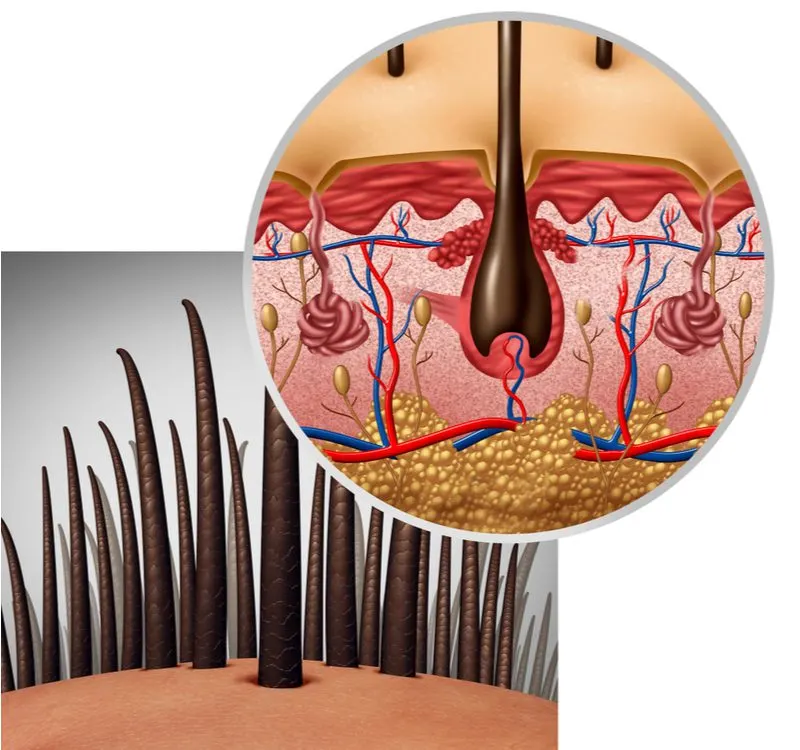Jump to:
Heard about the TikTok-popularized headache relief technique called hair cracking? This method involves gently pulling the hair to “pop” the scalp as a way to relieve pain and tension from a headache. Read on to learn more.
Hair Cracking — The TikTok Sensation
Hair cracking (sometimes called scalp popping) videos have been making the rounds on TikTok and other social networks over the last few months. You’ve heard of cracking or popping knuckles to relieve tension, but your hair and scalp don’t seem like ideal candidates for this kind of technique.
After all, there are no joints there to crack or pop. And yet, growing numbers of people are successfully popping their scalp or cracking their hair in videos online. They tug upward on sections of the hair, and an audible popping sound can be heard.
We’ve seen that it works, but we wanted to know more. What’s actually popping or cracking? Why does the hair cracking technique work on some but not others? Is it dangerous to do?
If you’ve got questions like these, or you’re just wondering what this DIY scalp tension relief technique is all about, we’ve got the answers you’re looking for. Find out what hair cracking is used for, how it works, where it originated, potential dangers, and whether it’s safe to try in our quick guide to hair cracking/scalp popping.
What Is Hair Cracking?

Everett Collection/Sutterstock
Hair cracking, aka scalp popping, involves twisting a very small section of hair tightly, then tugging upward on it until a distinct “pop” sound is heard. Users on TikTok have related this technique to popping or cracking knuckles as a way to relieve tension or pain on the scalp.
Hair cracking has its roots in Mexican, Peruvian, and possibly Indian cultures as a way to relieve headache or migraine pain. In these cultures, it’s considered a no-fail way to relieve the pain of a bad headache, especially one due to heat exposure.
Peruvian Brayan Coraza Morveli notes that what we consider hair cracking stems from an ancient treatment called chucaque, or chukake. He says chucaque is “…a traditional technique used by our grandparents to cure intense headaches when pills and other medicines were not available or ineffective.”
Julio Cachay, an Internist and Infectious Disease Specialist at Clínica Ricardo Palma in Peru, also says “hair cracking” is something most Peruvians were instructed to do by the generations before them as a cure for headaches and migraines.
“When your head hurts, probably you’ve been told to carry out the chucaque to relieve the pain. This ancient technique, which consists of rolling a lock of hair and then pulling it out, relieves that pain and isn’t dangerous. Chucaque is a tradition considered within traditional and alternative medicine. Many people carry it out and, so far, there is no risk evidence that compromises a patient’s health. On the contrary, it helps to ease the pain immediately.” -Julio Cachay, Internist and Infectious Disease Specialist
Similarly, the hair-pulling tension-relieving practice has been handed down through the generations in India, too.
Anya W., a woman from Northeast India, says, “We also have an old method of pulling the hair exactly the way you described it. Although I was a bit scared to try it myself, some of my friends could do it and I have seen it for myself. Unfortunately, this ancestral remedy is almost forgotten and only the old ageing people know and pass it down to their offsprings. It is a dying tradition.”
A licensed massage therapist, Jon Musgrave, noted that the hair cracking technique also roots as a Mexican tension and pain management method for heat-related migraines. He says the women in Mexico would tug upward on a small section of hair until they heard the tell-tale pop sound. This technique supposedly relieved some of the pain from heat-induced migraines.
It’s clear that this tension and pain-relieving method is nothing new – it’s just that it’s only recently been making the rounds on social media for the first time.
With so much history behind hair cracking and the chucaque method, it’s easy to assume it’s safe and it works. But like other ancient remedies, treatments, and techniques, this one deserves a closer look using the increased anatomical knowledge we have today.
We’ll take a look at the potential dangers of hair cracking or scalp popping in just a minute. But first, let’s walk through the step-by-step process of how the technique is done.
How to Crack Your Hair
Different cultures describe the practice of hair cracking or chucaque very similarly. A very small section of hair (called a mechón, or bundle, in Peru) is pulled gently until the pop sound is heard. Then, another section is grabbed, and the technique is repeated until the pain or tension is gone.
Morveli (quoted above) explains how traditional scalp popping or hair cracking is done in Peru:
- Massage the person’s head to relax the scalp and relieve tension first.
- Starting at the front of the head, grab a small section of hair between your thumb and forefinger.
- Gently pull or tug upward on the hair until you “hear a sound as if you were pulling something apart.” This is the “pop” in scalp popping, or the “crack” in hair cracking.
- Repeat the process, moving toward the back of the head. You can tug on sections where the pain is the worst to target the relief there.
With that said, we do not recommend cracking your hair or popping your scalp without the supervision of a medical professional.
While you may not notice anything wrong right away, it’s possible that you could cause damage to your scalp and the blood vessels that supply it by using this technique. We’ll talk more about the potential dangers of popping your scalp in just a bit.
What Causes the Popping Sound When You Crack Your Hair?

SL-Photography/Shutterstock
It’s both the most satisfying and off-putting thing about hair cracking: That suction-like pop sound you’ll hear when it’s done correctly. If you’ve watched the videos, you know exactly the sound we’re talking about. It’s strange enough to pique your curiosity, but it’s still kind of gross.
Ancient Peruvian cultures referred to the popping sound as conejos, meaning rabbit, and it’s the same word they used to describe the sound of popping joints or knuckles.
So what causes the popping sound when you crack your hair? Scientists aren’t entirely sure, mostly because this technique hasn’t been studied much. But it’s likely something to do with the separation of connective tissues under the scalp, including blood vessels, capillaries, and the thin fascia layer that separates your skull from your scalp.
As the scalp is lifted by tugging on hair, these layers are pulled up and away from the skull. If the motion is quick and targeted to a small section of the scalp, an audible pop sound will be heard as those layers separate and a suction vacuum is created.
Musgrave says, “When the skin gets pulled away from the bones quickly, it creates a vacuum that ‘pops’ as the edges lift and the space gets filled in by liquid, like pulling a suction cup off the shower wall.”
Still thinking hair cracking is something you might want to try? Make sure you read about the potential dangers first.
The Dangers of Hair Cracking or Scalp Popping

Lightspring/Shutterstock
If hair cracking or scalp popping has been around for centuries, how bad could it be? According to experts, it’s not a good idea to try. Here’s a look at the potential dangers and downsides of cracking your hair.
- Scalp popping can cause subgaleal hematoma: A subgaleal hematoma, or pool of blood that forms under the scalp, is a dangerous possibility if you pop your scalp or pull your hair too hard.
- Hair cracking can tear your skin: Tugging upward on your hair sharply can tear the skin on your scalp, which can be painful and lead to infection.
- Scalp popping can tear your connective tissues: The scalp isn’t meant to separate from the connective tissues that anchor it to the skull, and tugging upward on hair to “crack” it can result in microtears in the connective layers underneath.
- Hair cracking can lead to neck strain: Massage therapist Jon Musgrave notes neck strain is possible if you pop your scalp often. The tugging force can pull on your neck muscles and lead to strain.
A subgaleal hematoma is just a fancy way of saying “a pool of blood under the scalp.” One study looked at a hematoma like this that formed under the scalp of a young girl whose hair was pulled at school.
The outward tugging of the hair separated the thin connective tissue layers underneath and created a small “pocket” of air underneath the scalp. That pocket was then filled with blood and fluid as the traumatized blood vessels and capillaries leaked into the open vacuum the tugging had created.
While these circumstances are clearly different from the method used in hair cracking, the scenarios are still very similar. For this potential consequence alone, it’s best to avoid hair cracking altogether.
So, Is It Safe to Crack Your Hair?
We’ve looked at this thing from all angles – what it is, how it works, where it came from, and what causes the popping sound. We’ve talked about the potential dangers of popping your scalp. So, overall, is it safe to join the trend and crack your hair?
The answer is no. There are enough potential downsides and dangers involved to make hair cracking seem like a bad idea for the average person.
With the potential to separate those sensitive, blood vessel-filled connective tissues from your scalp and result in a hematoma, you’re better off avoiding this TikTok fad completely. If you’re experiencing a particularly bad headache, research shows that NSAID meds like ibuprofen, aspirin, and acetaminophen will knock any run-of-the-mill headache out.
For more severe headaches and migraines, add in some caffeine to boost the effects of any NSAID. But whatever you do, don’t look to hair cracking for relief. It could do more harm than good.
